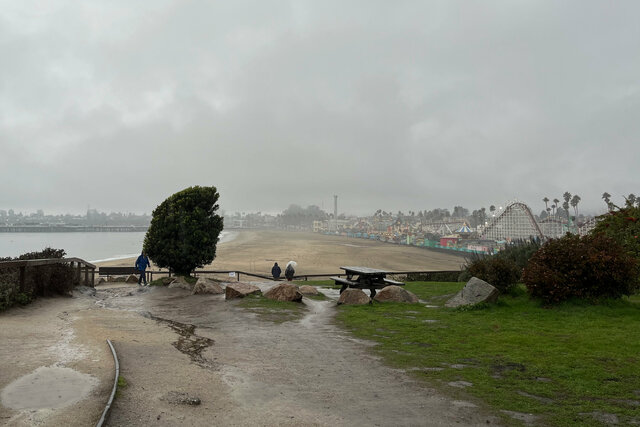Beach, bisected
Started: 2022-12-03 22:31:30
Submitted: 2022-12-03 23:20:28
Visibility: World-readable
Overlooking the rain on Main and Seabright beaches
Winter has come to Santa Cruz, and by "winter" I mean "colder temperatures and rain every once and a while".
Positioned in the middle of the Central California coast, Santa Cruz's seasons are attenuated due to the moderating influence of the Pacific Ocean. Monterey Bay remains an almost-constant 56° F year-round, cooling the coast in the summer and heating the coast in the winter (and providing a reliable source of moisture for the marine layer). Much of the winter is sunny and mild, but we do get rain, in distinct storms that roll in from the ocean and roll out within 48 hours.
This week we had rain on Thursday, then the storm cleared and the sun returned on Friday. (When I went running on Friday morning I saw a bathtub ring of sediment on the pedestrian paths on the sides of the San Lorenzo River.) Rain returned on Saturday, so in the afternoon I found my rain pants in the closet and went to the ocean overlook on East Cliff Drive to watch the storm.
This storm was all rain, no wind, so the ocean was calm as the rain fell from the sky. From the overlook on the cliff above the San Lorenzo River I could see the Santa Cruz Beach Boardwalk in the rain, its rides lit up without anyone to ride them. The river itself had overcome the sand dike that turns the river into a lagoon in the summer and was flowing into the ocean, at a moderate rate of flow that didn't seem to have quite caught up to the day's rain.
Main Beach in front of the boardwalk was almost completely deserted, with the exception of one pair of people who were walking on the beach in rain coats, short pants under their coats, and tall boots. That, I presumed, was one strategy for keeping one's pants dry; but it did not seem to be an especially effective strategy for keeping one's legs dry.
In front of me under the cliffs was Seabright Beach, which had been transformed by the storm. A new lagoon had formed in the middle of the beach, bisecting it immediately in front of the main entrance gate. There was a storm drain collecting water from the street in front of the main gate and releasing it onto the beach, opposite the houses built on East Cliff Drive.
The pond wound around the gentle depression in front of what was clearly an intermittent creek on the beach, in front of the lifeguard towers that had been moved to the base of the cliffs for the winter season. It cut through the sand and cascaded in a torrent into the ocean, in one of the shortest possible water-cycle journeys.
The new stream separated me from the other half of Seabright Beach, ending at the jetty forming the entrance to the small-craft harbor, built out of tetrapods extending into the ocean capped by a small lighthouse. (The stream was only a couple of inches deep in most places, but I did not feel inclined to get my feet wet crossing the stream.) I could see the jetty and the lighthouse in the distance on the other side of the pond, through the rain and the fog.
The rain continued as I returned to my car parked on the top of the cliff, overlooking the gentle seas under an early-winter storm.






